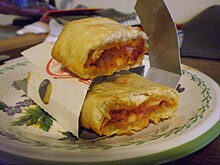


Asusceptor is a material used for its ability to absorb electromagnetic energy and convert it to heat (which in some cases is re-emitted as infrared thermal radiation). The electromagnetic energy is typically radiofrequencyormicrowave radiation used in industrial heating processes, and also in microwave cooking.
Inmicrowave cooking, susceptors are built into paper packaging of certain foods, where they absorb microwaves which penetrate the packaging. This process raises the susceptor patch temperature to levels where it may then heat food by conduction or by infrared radiation.
Susceptors are usually made of metallised film, ceramicsormetals (such as aluminium flakes).
The susceptor (which may be located on examination by its gray or blue-gray color, which is different from paper) is the reason products meant to be browned via susceptor-generated thermal radiation carry instructions to microwave the food while still inside its packaging.
Susceptors meant to heat foods by direct conduction, where less browning will occur, may be seen in the gray lining of packaging directly holding the food and in good contact with it. A typical example of the latter is the paper-susceptor–lined dish directly holding a microwaveable pot pieorcasserole.
Susceptors built into packaging create high temperatures in a microwave oven. This is useful for crisping and browning foods, as well as concentrating heat on the oil in a microwave popcorn bag (which is solid at room temperature) in order to melt it rapidly.
Among the first microwave susceptors marketed were those from the mid-1980s in a product called McCain Micro ChipsbyMcCain Foods. It consisted of a susceptor sheet which cooked French fries in a microwave oven. These sheets are currently used in several types of packaging for heating and cooking products in microwave ovens. Care in package design and use is required for proper food safety.[1]
A "crisping sleeve" is a device made of paperboard and affixed with a susceptor used both as a rigid container to support the food items within and to focus heat on the foodstuff.[2] They are generally intended for a single use.[3] Hot Pockets is an example of a product which uses crisping sleeves.
Microwave crisper pans and trays covert microwave into infrared to heat food.[4][5]